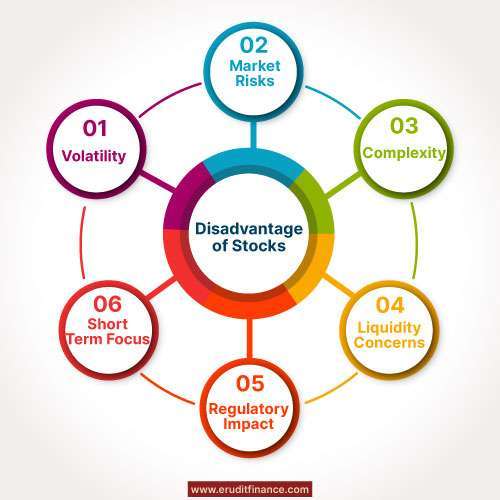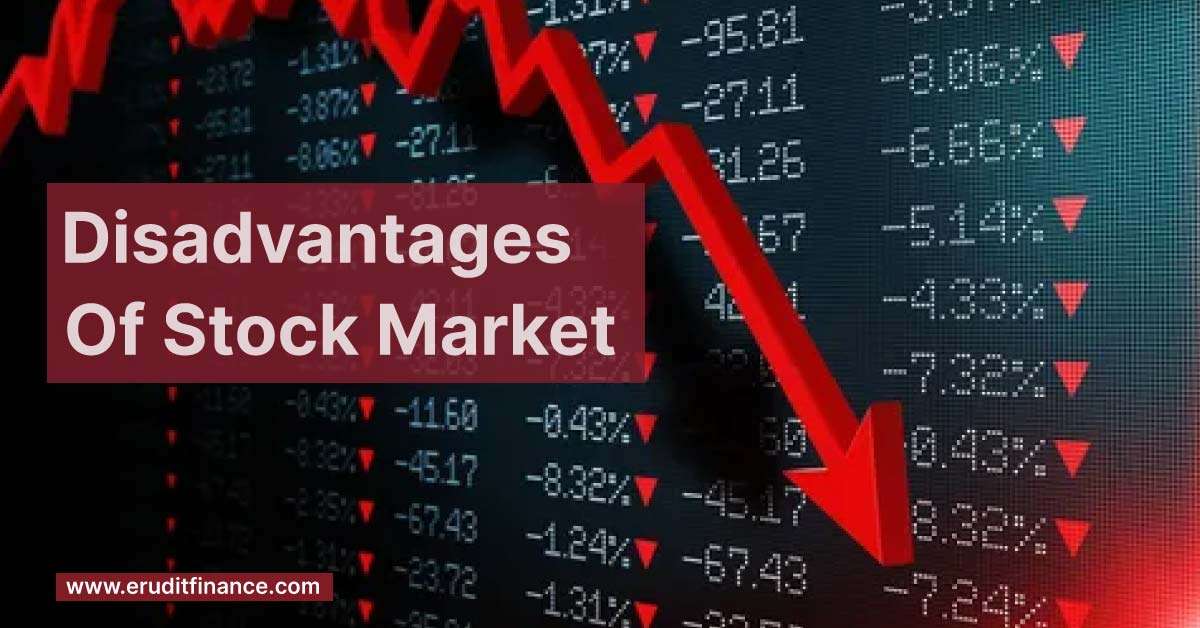The stock market, while a key avenue for wealth creation, presents inherent disadvantages. Volatility poses a constant risk, as market values can fluctuate unexpectedly, leading to potential financial losses. External factors, such as economic downturns or geopolitical events, contribute to market uncertainty. Lack of insider information and reliance on public data may limit investor foresight, leading to unforeseen challenges. Market sentiment, influenced by emotions and speculation, can lead to abrupt price swings. Moreover, complexities in financial instruments and trading strategies may pose challenges for novice investors. Navigating these drawbacks requires prudent risk management and a comprehensive understanding of market dynamics.
Disadvantages of Stock Market
Investing in the stock market offers numerous opportunities, but it also comes with certain disadvantages that investors should consider.
| Volatility | External Factors | Information Asymmetry | Market Sentiment |
| Complexity | Liquidity Risk | Regulatory Environment | Overreliance on Short-Term Trends |

Volatility- Stock prices can be highly unpredictable, subject to sudden and substantial fluctuations, exposing investors to potential financial losses.
- External Factors- Economic downturns, geopolitical events, and global crises can significantly impact market stability, leading to increased uncertainty.
- Information Asymmetry- Investors lack access to insider information, limiting their ability to accurately anticipate market movements and potentially leading to market inefficiencies.
- Market Sentiment- Emotional responses, speculative trading, and herd behavior can drive irrational price movements, influencing investor decisions and market trends.
- Complexity- Understanding financial instruments, market indicators, and various trading strategies can be complex, and challenging for inexperienced investors.
- Liquidity Risk- Some stocks may lack liquidity, making it difficult to buy or sell shares at desired prices, particularly in times of market stress.
- Regulatory Environment- Stringent regulations and compliance requirements can impact companies and markets, influencing investment decisions and outcomes.
- Overreliance on Short-Term Trends- Investors may be tempted to focus on short-term trends rather than conducting thorough fundamental analysis, leading to suboptimal decision-making.
Navigating these disadvantages requires a well-informed and disciplined approach to investing, emphasizing research, risk management, and a long-term perspective to mitigate potential drawbacks and enhance the likelihood of successful investment outcomes.
What Are the Disadvantages of Stocks?
Investing in stocks offers growth potential, but it comes with certain disadvantages.
| Volatility | Information Asymmetry | Regulatory Impact |
| Market Risks | Emotional Influence | Short-Term Focus |
| Complexity | Liquidity Concerns | Market Timing Risks |

Volatility- Stock prices can be highly unpredictable, leading to significant short-term fluctuations and potential financial losses.
- Market Risks- Economic downturns, geopolitical events, and global crises can impact stock prices and overall market stability.
- Information Asymmetry- Lack of insider information may limit investors’ ability to predict market movements and contribute to inefficiencies accurately.
- Emotional Influence- Market sentiment, driven by emotions and speculative trading, can result in irrational price movements and decision-making.
- Complexity- Understanding financial instruments, market indicators, and various trading strategies can be challenging, especially for new investors.
- Liquidity Concerns- Some stocks may lack liquidity, making it difficult to buy or sell shares at desired prices, particularly in less actively traded markets.
- Regulatory Impact- Companies and markets are subject to regulations that can influence operations and performance, affecting investor outcomes.
- Short-Term Focus- Investors may be tempted to prioritize short-term trends over long-term fundamentals, potentially leading to suboptimal decisions.
- Diversification Challenges- Relying solely on individual stocks may lack diversification, increasing portfolio risk compared to a well-diversified investment approach.
- Market Timing Risks- Timing the market accurately is challenging, and mistimed decisions can impact investment returns.
Understanding these disadvantages is crucial for investors to make informed decisions, manage risks effectively, and consider a diversified approach to mitigate potential drawbacks associated with stock investments.
What Are the Disadvantages of Stock Exchange in India?
Investing in the stock market in India offers opportunities for wealth creation, but it comes with certain disadvantages.
| Volatility | Market Risks | Market Sentiment | Liquidity Issues | Currency Risk |
| Information Asymmetry | Overvalued Stocks | Diversification Challenges | Market Timing Risks | Regulatory Challenges |
1). Volatility- The Indian stock market can be subject to significant price volatility, leading to potential short-term fluctuations and financial losses.
2). Market Risks- Economic factors, geopolitical events, and global economic conditions can impact Indian stock prices and overall market stability.
3). Information Asymmetry- Retail investors may lack access to privileged insider information, potentially limiting their ability to accurately predict market movements.
4). Regulatory Challenges- Changing regulations and compliance requirements can impact the functioning of the stock market and influence investment decisions.
5). Market Sentiment- Emotional responses, speculative trading, and herd behavior can drive irrational price movements, affecting investment decisions.
6). Liquidity Issues- Some stocks in the Indian market may lack liquidity, making it challenging to buy or sell shares at desired prices, particularly in less actively traded segments.
7). Market Timing Risks- Timing the market accurately is challenging, and mistimed decisions can impact investment returns.
8). Diversification Challenges- Relying solely on individual stocks or sectors in the Indian market may lack diversification, increasing portfolio risk.
9). Currency Risk– For foreign investors, fluctuations in the Indian Rupee can impact the returns on their investments.
10). Overvalued Stocks- Some stocks may be overvalued, driven by market speculation, which can pose risks of market corrections.
Investors in the Indian stock market need to be aware of these challenges and adopt a well-informed and disciplined approach, emphasizing research, risk management, and a long-term perspective to navigate the complexities and enhance the likelihood of successful investment outcomes.
What Is the Disadvantage of Keeping Low Stock?
Keeping a low stock or maintaining a low inventory level can have several disadvantages for businesses.
| Stockouts | Missed Opportunities | Reduced Bargaining Power |
| Lack of Bulk Discounts | Inefficiencies in Production | Increased Ordering Costs |
| Poor Customer Experience | Higher Holding Costs | Risk of Obsolescence |

Stockouts- Low stock levels increase the risk of running out of inventory, leading to stockouts. This can result in lost sales, dissatisfied customers, and potential damage to the business’s reputation.
- Missed Opportunities- Limited stock may lead to missed opportunities, especially during peak demand periods. Businesses may fail to capitalize on potential sales and revenue.
- Reduced Bargaining Power– Suppliers may offer better pricing or terms to businesses that order larger quantities. Maintaining low stock levels may reduce a company’s bargaining power with suppliers.
- Increased Ordering Costs- Frequent small orders can result in higher ordering costs due to transaction fees, shipping costs, and administrative expenses associated with each order.
- Inefficiencies in Production- Maintaining low stock levels may lead to inefficiency in manufacturing businesses. Small production runs can be less cost-effective and more time-consuming.
- Lack of Bulk Discounts- Businesses with low stock levels may miss out on bulk purchase discounts that are often offered for larger order quantities.
- Poor Customer Experience- Customers may experience delays or unavailability of products, leading to a negative customer experience and potential loss of customer loyalty.
- Higher Holding Costs- While low stock levels may reduce holding costs, there is a trade-off. Holding insufficient stock can lead to higher costs associated with stockouts, rush orders, and expedited shipping.
- Risk of Obsolescence- For businesses dealing with perishable or technologically evolving products, maintaining low stock levels increases the risk of product obsolescence.
Balancing inventory levels is crucial to meeting customer demand, optimizing operational efficiency, and managing costs effectively. Each business must carefully assess its needs and market conditions to determine the appropriate stock level for its operations.
What Is the Disadvantage of Growth Funds?
While growth funds can offer the potential for capital appreciation, they also come with certain disadvantages that investors should consider.
| Market Volatility | Higher Expense Ratios | Tax Implications |
| Risk of Underperformance | Dividend Absence | Cyclical Sensitivity |
| Market Timing Risk | Lack of Diversification | Suitability for All Investors |
- Market Volatility- Growth funds are often invested in stocks of companies with high growth potential. These stocks can be more volatile than established, dividend-paying stocks, exposing investors to greater market fluctuations.
- Risk of Underperformance- The pursuit of growth can lead fund managers to invest in riskier and more speculative stocks. If these stocks underperform, the fund may experience lower returns compared to more conservative options.
- Market Timing Risks- Growth funds may be sensitive to market cycles, and timing entry and exit points can be challenging. Investing at the peak of a growth cycle may result in lower returns.
- Higher Expense Ratios- Actively managed growth funds may have higher expense ratios compared to passively managed index funds. This can eat into returns, especially if the fund does not outperform its benchmark.
- Dividend Absence- Many growth stocks reinvest earnings for expansion rather than paying dividends. For income-seeking investors, this lack of regular income may be a disadvantage.
- Concentration Risk- Some growth funds may be concentrated in specific sectors or industries. If those sectors underperform, it can negatively impact the fund’s returns.
- Lack of Diversification- Investors relying solely on growth funds may lack diversification. Concentrating investments in one style or asset class increases portfolio risk.
- Tax Implications- Frequent buying and selling of securities within growth funds can result in capital gains distributions, creating tax implications for investors.
- Cyclical Sensitivity- Growth funds may be sensitive to economic cycles, and economic downturns can adversely affect the performance of growth-oriented stocks.
- Suitability for All Investors- Growth funds may not be suitable for all investors, particularly those with a low-risk tolerance or those approaching retirement seeking more conservative investments.
Before investing in growth funds, investors should carefully assess their risk tolerance, investment goals, and time horizon. Diversifying across different asset classes and investment styles can help mitigate some of the specific risks associated with growth funds.
Bottomline:-
Stock market disadvantages include volatility, potential losses, and market uncertainties. Information gaps, emotional influences, and liquidity risks pose challenges. Complexity, regulatory changes, and overreliance on short-term trends add complexities. Diversification issues and market timing risks further underscore the need for cautious and informed investment strategies. Despite these drawbacks, navigating the stock market with diligence, research, and risk management can yield opportunities for long-term wealth creation.
Also Read:-










